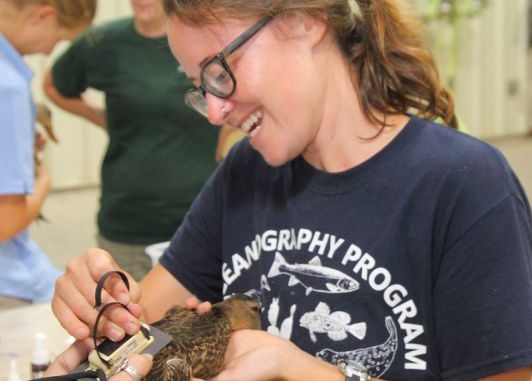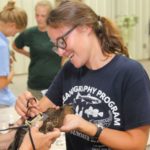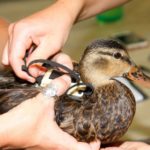
Goal is to determine nesting success of reclusive ducks
The mottled duck’s ongoing population struggles, which prompted officials to reduce the daily limit to one bird eight years ago, now are the reason for a telemetry study designed to help researchers locate their nests to determine nesting success.
Elizabeth Bonczek, a Louisiana State University graduate student working on her PhD, says a lot of studies have been conducted on the reclusive ducks — but there’s still much to learn about the species.
“The whole goal of my project is to find nests,” Bonczek said. “I’m going to be looking at nesting success, adult survival, female breeding propensity and nest site selection and how all that relates to landscape characteristics.”
How Bonczek plans to be more successful is by attaching Global Positioning System / Global System for Mobile (GPS/GSM) transmitters on female mottled ducks to locate them during the spring nesting period. Biologists previously used Very High Frequency (VHF) radio telemetry antennas to track the ducks — but VHF antennas were only accurate to within one kilometer.
By contrast, GPS/GSM tracking devices are accurate to within 30 meters, which is significant because of the mottled duck’s reclusive nature. Locating a nest in the extensive marshes of coastal Louisiana can be like finding a needle in a haystack — so the GPS/GSM transmitters will help Bonczek dial in a mottled duck’s position to a more finite geographic location.
In late summer, biologists with the Louisiana Department of Wildlife and Fisheries assisted Bonczek by coordinating capture efforts on Rockefeller Wildlife Refuge.
Mottled ducks molt annually at that time, rendering them flightless. Using airboats and hand-held lights, the ducks were spotted, caught and placed in crates by biologists and technicians working in teams.
All birds captured were banded, measured and weighed. Only 65 of the healthiest adult females received transmitters.
“The U.S. Geological Survey Bird Banding Laboratory doesn’t like any auxiliary devices like transmitters used that are more than 3 percent of the bird’s body weight. Transmitters are 16 to 18 grams, so the lowest body weight we could attach them to was 670 grams,” Bonczek said. “But, all of the birds we placed transmitters on were between 700 and 800 grams. If there was any inkling of a scratch, the bird was banged up, or looks suspicious you don’t want to put a unit on them.”
Her plan is to place transmitter units on 65 more mottled ducks next year to continue the study.
“Dabbling ducks on the prairies we know have a breeding propensity that’s pretty close to 100 percent for mallards. But, studies on mottled ducks in Florida and Texas show breeding propensity ranges a lot,” she said. “There was one study in Texas done that found one year 15.3 percent of mottled ducks bred. The next year it was 63 percent. We don’t actually know how many birds are choosing to breed, so mottled ducks are a little bit different. We’re just not sure.”
Transmitters come with a price tag of approximately $1,700 each, not including the cost of data collecting. Additionally, capture operations require a large commitment of equipment and manpower.
But come spring, Bonczek’s research should begin to pay dividends that will help biologists understand more about mottled ducks, particularly when the telemetry units lead her to nests to determine breeding success.


